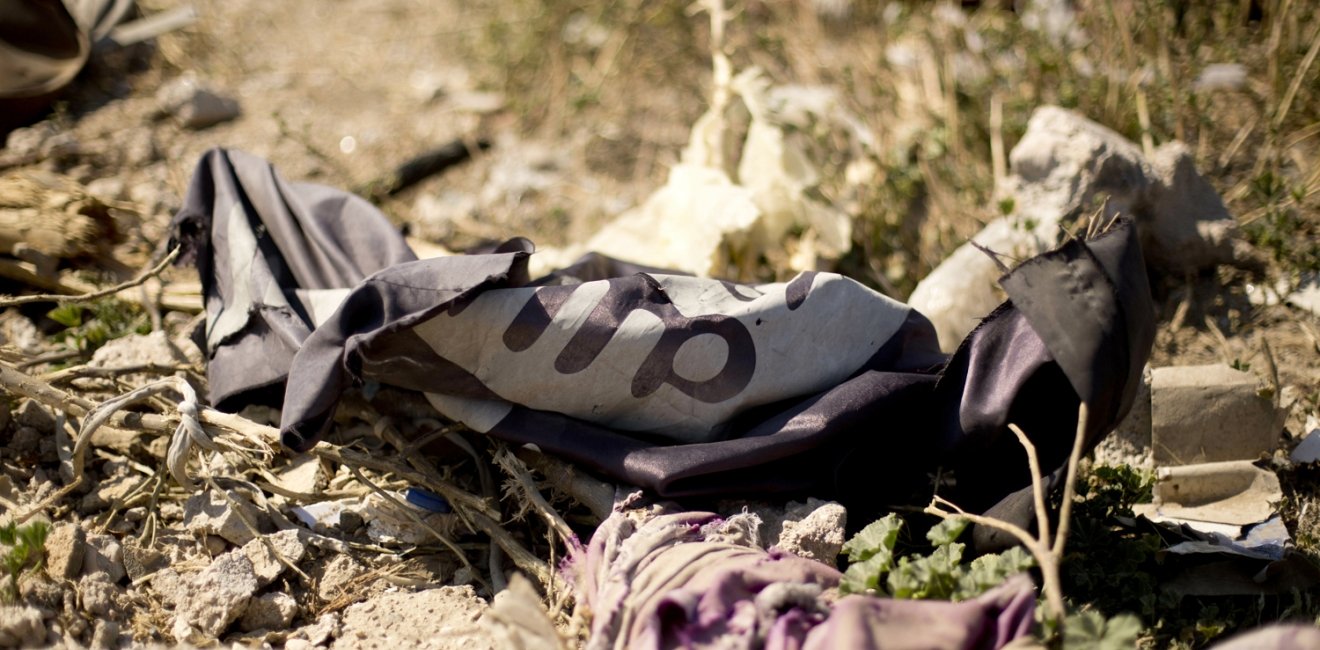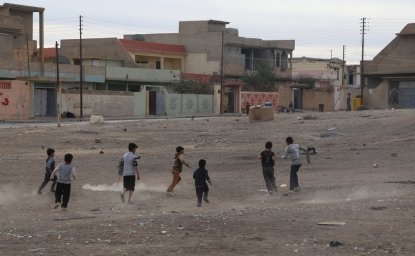Nearly two years after the caliphate’s collapse, ISIS had some 10,000 fighters challenging U.S. interests in Iraq and Syria, with the potential to regain control of territory and regenerate jihadi-run fiefdoms. Without sustained military pressure, ISIS could gain footholds “in a relatively short period of time,” General Kenneth McKenzie Jr., the head of U.S. Central Command, warned in August 2020.
In October 2020, the Department of Homeland Security cautioned that the main threats to U.S. interests were overseas. “Nevertheless, these groups can adapt quickly and resurge, and terrorists overseas will continue to probe for vulnerabilities in U.S. immigration and border security programs,” the agency said in its first annual risk assessment. The United States also faced the possibility of domestic attacks by lone wolves inspired by ISIS. The report noted that calls for attacks had increased since ISIS leader Abu Bakr al Baghdadi was killed during a U.S. raid in October 2019.
The jihadis have proven resilient despite ongoing airstrikes and ground operations by the U.S.-led Global Coalition to defeat ISIS, which consists of more than 75 countries and local military partners. From August 2014 to October 2020, the coalition launched nearly 35,000 airstrikes in Iraq and Syria. But ISIS fighters moving freely in small cells evaded capture by moving into deserts and mountains, especially along the border between Iraq and Syria. ISIS “continued to consolidate its position in some areas previously under its control, operating increasingly confidently and openly,” Vladimir Voronkov, head of the U.N. Office of Counter-Terrorism, told the Security Council on August 24, 2020.
Since the Islamic State lost its Iraqi territory in November 2017, ISIS has been active in Iraq’s central and northern provinces, including Anbar, Baghdad, Diyala, Kirkuk, Ninewa and Salah al Din. ISIS initially launched hit-and-run operations against security forces and civilians using small arms, improvised explosive devices (IEDs) and mortars. In the second quarter of 2020, it began organizing larger attacks that killed more than 20 people, which reflected “extensive pre-operational planning and preparation,” U.S. Central Command reported. In the third quarter of 2020, ISIS primarily attacked local security forces to increase its freedom of movement. It usually operated in groups of 15 or fewer.
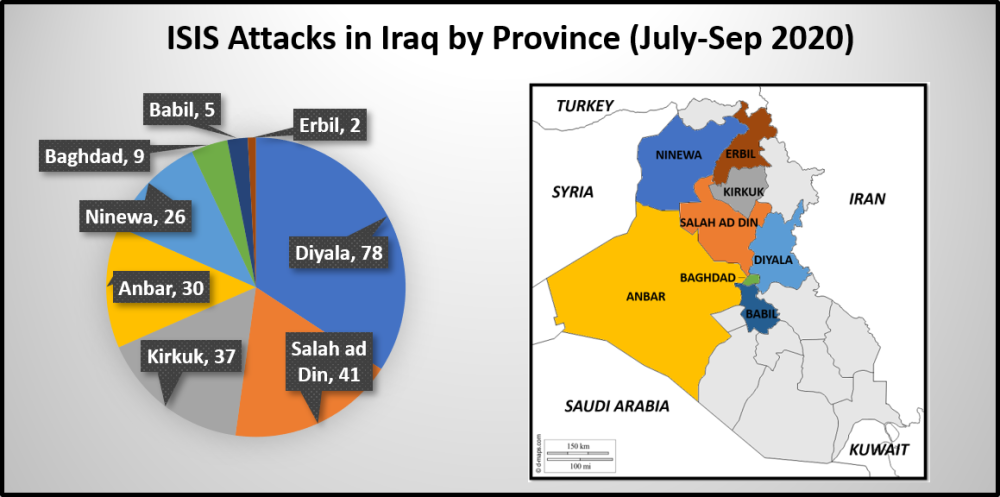
Since the Islamic State fell in Syria and the caliphate collapsed in March 2019, ISIS launched hundreds of attacks primarily in the central desert region, in the east near the Iraqi border and to a lesser extent in the south near the Jordanian border. Nearly half of the 131 attacks in the third quarter of 2020 were in Deir Ezzor Province, in the east; 13 percent of attacks were in Raqqah Province, which includes the caliphate’s former capital in the north. The Pentagon warned that ISIS had also become capable of seizing areas controlled by the Assad regime. The economic and political conditions in Syria were “as bad as or worse than those that spawned the original rise of ISIS,” McKenzie said. He warned that ISIS operated with “more freedom” in Assad territory west of the Euphrates River and in the central Badia desert.
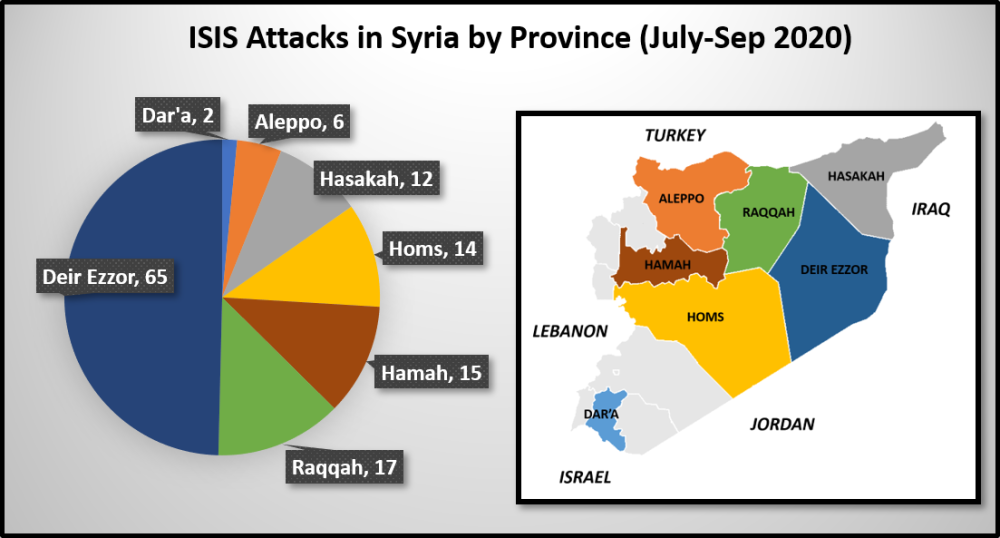
In both Iraq and Syria, the U.S.-led Global Coalition has implemented a holistic strategy against ISIS, including:
- Killing or capturing fighters
- Choking off the flow of finances
- Stemming the flow of foreign fighters to and from Iraq and Syria
- Countering ISIS messaging on social media
- Strengthening security in prisons and displaced persons camps
- Providing stabilization and humanitarian assistance to liberated areas
Stabilization assistance has often included providing essential services to help communities rebuild. In Iraq, and to a lesser extent, Syria, the coalition members have partially funded water infrastructure and refurbishing schools and hospitals. “The amount of time and resources necessary to address these conditions is significant,” McKenzie said in August. But COVID-19 and the “malign influence of Iran in both Iraq and Syria” further impeded the Coalition’s work, he added.
The United States also helped identify the 2,000 foreign fighters imprisoned in Syria and 1,000 in Iraq, including Americans, who often used noms de guerre and hid their nationalities after being captured or surrendering. On October 1, the Justice Department announced that the United States had repatriated 27 Americans, including fighters and family members, from Iraq and Syria, including 10 charged with supporting ISIS. “With this week’s repatriations, the United States has brought back every American supporter of ISIS known to be held by the Syrian Democratic Forces against whom we have charges,” John Demers, Assistant Attorney General for National Security, said in a statement. The United States also indicted two British citizens who were members of “The Beatles,” four ISIS fighters who allegedly played roles in the murder American hostages in Syria.
Post-ISIS Operations in Iraq
Iraqi Security Forces (ISF), with air support from the U.S.-led coalition, captured Mosul, Iraq’s second largest city, in mid-2017 and Rawa, the last Iraqi town under ISIS control, in late 2017. ISIS was unable to recover from the loss; the need for U.S. air support waned. Coalition airstrikes plummeted by 88 percent—from 255 in September to 29 in December 2017. Coalition military support shifted to advising and training Iraqi forces as the war turned into an insurgency by small cells of ISIS fighters.
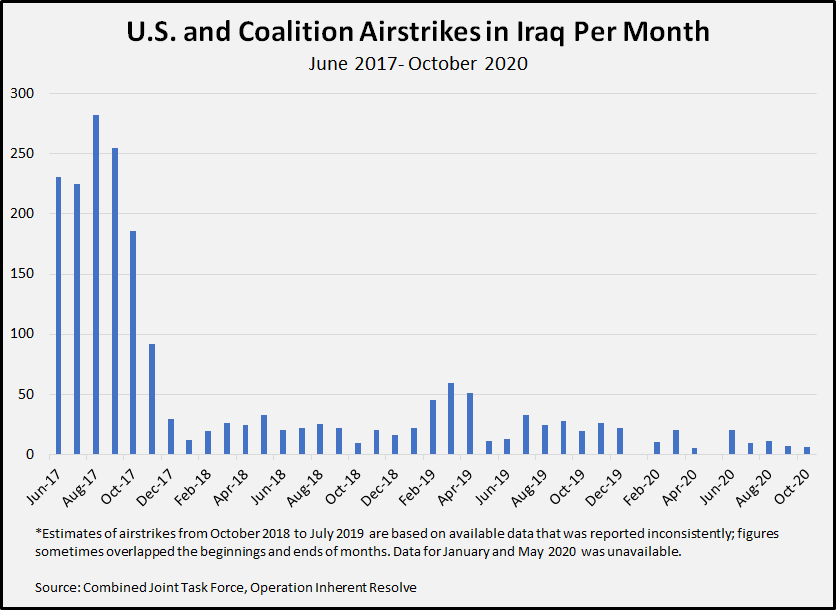
ISIS attacks diminished after it lost territory. Over a two-year period, between 2017 and 2018, its monthly attacks fell 75 percent. In 2019, ISIS operations slightly increased.
- 2017: 5,892 in 2017, or an average of 491 a month
- 2018: 1,476, or an average of 123 per month
- 2019: 1,669, or an average of 139 per month
Fatalities and injuries also fell significantly after 2017, the State Department reported.
- 2017: 3,000 civilians killed and 4,600 injured
- 2018: 900 civilians killed and 1,600 injured
- 2019: 534 civilians killed and at least 1,121 injured
From mid-2019 to mid-2020, ISIS attacks escalated against government, military and civilian targets just as the U.S.-led coalition reduced training and combat support. By August 2020, it had transferred its portions of eight bases to the Iraqi military. “The Coalition’s efforts have enabled the Iraqis to train themselves,” Maj. Gen. Kenneth Ekman, deputy coalition commander, said on August 23, 2020. The transfer of bases is “part of our campaign plan for the ISF to secure their own future and defend Iraqi sovereignty.”
In September 2020, the United States announced a drawdown of almost half its troops –from about 5,200 to 3,000 – “in recognition of the great progress the Iraqi forces have made,” McKenzie said. “This reduced footprint allows us to continue advising and assisting our Iraqi partners in rooting out the final remnants of ISIS in Iraq and ensuring its enduring defeat.”
But the U.S. coalition faced additional challenges from Shiite militias backed and armed by Iran—some of which had been de facto allies in fighting ISIS between mid-2014 and early 2019. The militias—several that were members of the Popular Mobilization Forces, which government incorporated in 2016—targeted coalition facilities, convoys and personnel, although most attacks were not lethal. But the threat diverted military resources from fighting ISIS.
The coalition also supported stabilization and reconstruction programs, such as resettling displaced Iraqis and restoring electricity, water, education and health services. Between 2015 and late 2020, the United States and 27 of its coalition partners provided more than $1.4 billion for some 3,000 projects in 31 liberated towns and districts. But reconstruction was reportedly stymied by Iraq’s inefficient and corrupt bureaucracy as well as the ongoing ISIS attacks.
Post-ISIS Operations in Syria
Backed by massive coalition airstrikes, the Syrian Democratic Forces (SDF) captured the last ISIS stronghold, Baghouz, a village along the eastern border with Iraq on March 23, 2019. As ISIS lost its last territory, coalition airstrikes fell from 1,220 strikes in January 2019 to none in May—because ISIS was not able to regroup in Syria as it had in Iraq. As of mid-2020, the Pentagon reported that the small ISIS cells attacked the SDF with small arms and bombs. The U.S. troop presence declined—from 2,000 in early 2019 to 900 troops by September 2020.
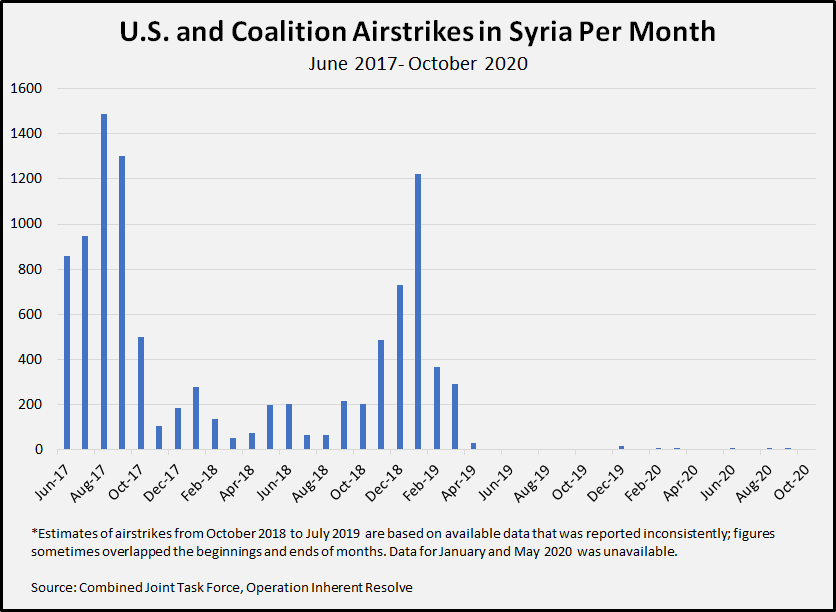
The main U.S. role was helping the SDF find and target ISIS leaders in hiding. On October 26, 2019, ISIS leader Abu Bakr al Baghdadi blew himself up during a joint raid by U.S. special forces and the SDF. President Trump then outlined a new priority for U.S. troops to secure oil installations once controlled by ISIS that the SDF seized. “What I intend to do, perhaps, is make a deal with an Exxon Mobil or one of our great companies to go in there and do it properly,” he said. He then ordered reduced support for the SDF. In July 2020, Delta Crescent Energy, headquartered in Delaware, signed a deal with the Autonomous Administration of Northeast Syria, the local political authority in SDF-held territory, to upgrade the oil infrastructure and bring the oil to market. U.S. forces in northeast Syria were securing petroleum infrastructure in northeast Syria “to deny ISIS access to critical resources and revenue,” the Pentagon said in August 2020.
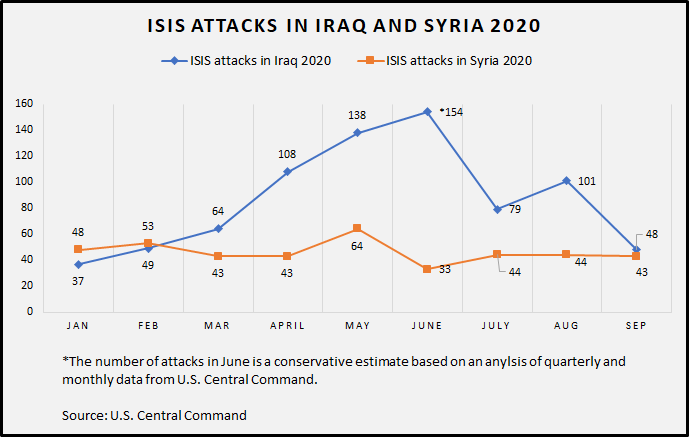
Unlike in Iraq, the United States limited support for stabilization projects in Syria. The Trump administration cut $230 million of aid in August 2018. But it allocated $14 million in 2018 to sustain existing projects. As of 2020, many projects were in Deir Ezzor and Raqqa provinces for education, community security, civil society, local governance, water and waste management. In 2019, it also allocated $50 million to aid Syria’s religious and ethnic minorities. As of late 2020, the State Department was still awarding its portion of the funding, $33.5 million. The remainder was used to support USAID programs.
American Foreign Fighters
The United States also had to deal with foreign fighters in Iraq and Syria. Between 2011 and 2017, at least 64 Americans joined a jihadi group in Iraq and Syria, 53 of whom joined ISIS. Many served in combat roles, while others worked in logistics, finance and running the Islamic State. Twenty-two reportedly died in Syria. Few Americans rose to senior positions.
By October 2020, the United States had repatriated 27 Americans from Iraq and Syria. Ten of the 27 returnees were charged with terrorism-related offenses. The United States may repatriate other Americans, Assistant Attorney General for National Security Demers implied. “The Department of Justice will review the facts and circumstances relating to any future detainees and, where warranted, bring additional charges against others,” he said. The following are profiles of the nine men and one woman publicly charged by the Justice Department.
Emraan Ali and Jihad Ali: The father and son joined ISIS in Syria in 2015. They allegedly received military and religious training from ISIS and served as fighters. The two men surrendered to the SDF near Baghouz as the Islamic State collapsed in March 2019. They appeared in court in the Southern District of Florida on September 30, 2020. They were charged with providing material support to a terrorist group. Emraan is a naturalized citizen born in Trinidad and Tobago; his son Jihad was born in New York
Ruslan Maratovich Asainov: Asainov allegedly traveled to Turkey in December 2013 and continued onto Syria, where he joined ISIS. He started out as a sniper and eventually became an “emir” responsible for military training. He was detained by the SDF before being transferred to FBI custody in July 2019. On September 3, 2019, a five-count indictment was filed in a federal court in Brooklyn against Asainov. The charges included providing material support to a terrorist group, receiving military training from ISIS and obstruction of justice.
Warren Christopher Clark: The former substitute teacher and Muslim convert told NBC News that he traveled to Syria in June 2015. He offered to work for ISIS as an English teacher. Clark claimed that he was detained several times for refusing to fight. Clark was captured by the SDF in January 2019. The indictment against him was unsealed after he appeared in federal court in Houston on January 25. Clark was charged with attempting to provide himself as material support to a terrorist organization.
Samantha Marie Elhassani: In 2014, Elhassani helped her husband and his brother to travel to Syria to join ISIS. She smuggled more than $30,000 in cash and gold to Hong Kong between November 2014 and April 2015 to help finance the trip to Syria. Samantha and her husband, Moussa, and their two children traveled to Syria in 2015. Moussa was killed in an airstrike in 2017. Elhassani and her children, including two born in Syria, were captured by the SDF and held in camps until they were extradited back to Indiana in July 2018. On November 25, 2019, she pleaded guilty to a one-count Information charging her with concealment of terrorism financing. She was due to be sentenced in August 2020, but the sentencing was postponed.
Mohamad Jamal Khweis: In December 2015, Khweis left the United States for Turkey. He crossed into Syria later that month. He went to Raqqa, where he joined ISIS and agreed to be a suicide bomber. During his two and half months with ISIS, he participated in religious training, attended lectures, gave money to ISIS members. He was deployed to Tal Afar, Iraq before he was detained by Kurdish Peshmerga forces. On October 27, 2017, the former resident of Alexandria, Virginia was sentenced to 20 years in prison for providing material support to a terrorist organization.
Omer Kuzu: Omer and his brother, Yusuf, left Texas for Turkey on October 16, 2014 and later were smuggled across the Syrian border by ISIS. They participated in five days of physical and weapons training with 40 other foreign fighters in Mosul, Iraq. The brothers were then to Raqqa, Syria, where Omer started working in the ISIS telecommunications directorate. After pledging allegiance to al Baghdadi, he received a monthly stipend and an AK-47 rifle. Kuzu also took an ISIS bride before deploying to Kobani and Hama. In March 2019, he and 1,500 suspected ISIS fighters were captured by the SDF. He was then extradited to the United States. On September 2, 2020, he pled guilty to conspiring to provide material support to a terrorist group.
Abdelhamid al Madioum: In June 2015, al Madioum and his family traveled from Minnesota to Casablanca, Morocco, to visit family. In July, he secretly traveled to Turkey and then to Iraq and Syria. Al Madioum, a naturalized U.S. citizen from Morocco, allegedly joined ISIS from mid-2015 until he was captured by the SDF in March 2019. While in prison, he claimed that he was never an ISIS fighter and that he had hoped to become a doctor. Al Madioum was extradited to Minnesota. On September 16, 2020, he was charged with providing material support to a terrorist organization.
Ibraheem Izzy Musaibli: Musaibli’s family said that he moved from Dearborn, Michigan to Yemen’s port city of Aden in early 2015 and was then was tricked into traveling to Syria to study religion and work. “He had NO idea this group was ISIS,” Musaibli’s brother claimed. But the indictment against Musaibli alleged that he knowingly joined the terrorist organization in April 2015 and that he received military training during his three years with ISIS. He was captured by the SDF and transferred to U.S. custody in July 2018.
In July 2018, Musaibly was charged with providing and attempting to provide material support to a terrorist organization. On April 10, 2019, he was charged with additional offenses of conspiring to provide material support to ISIS, possessing and discharging a machine gun in furtherance of a crime of violence, and receiving military training from ISIS.
Lirim Sylejmani: In November 2015, Sylejmani, a naturalized U.S. citizen from Kosovo, traveled from Chicago to Kosovo with his wife and two children. They continued onto Turkey and then to Syria, where he joined ISIS. Sylejamni told The New Yorker that he received some military training but never fought. He spoke to several media outlets about his time with ISIS after his capture by the SDF in 2019. On September 16, 2020, he was charged with providing material support to a terrorist organization.
American Victims of ISIS
The United States also tried to seek justice for the murder of American citizens by ISIS fighters. The Justice Department sought extradition of two ISIS fighters — Alexanda Kotey and El Shafee Elsheikh—who held British citizenship and were captured in Iraq. They were charged with an ISIS hostage scheme that resulted in the deaths of four Americans—James Foley (2014), Steven Sotloff (2014), Peter Kassig (2014) and Kayla Mueller (2015) —as well as two British citizens and two Japanese.
Kotey and Elsheikh were among four British members of ISIS dubbed “The Beatles” for their accents. Another member of “The Beatles,” Mohammed Emwazi — better known as “Jihadi John”— beheaded Foley, Sotloff and British citizens David Haines and Alan Henning in ISIS videos released in 2014. Emwazi, Kotey and Elsheikh allegedly physically and psychologically abused the hostages. Emwazi was killed in a U.S. airstrike in Syria in November 2015. The indictment also said that Kotey and Elsheikh worked closely with Abu Muhammad al Adnani, a top ISIS commander and chief media spokesperson who was killed in a U.S. airstrike in Syria in August 2016.
Britain agreed to let the United States try them on condition that the death penalty was not applied. It was the first time ISIS members were implicated in the deaths of U.S. citizens in a U.S. court. They appeared in court in Alexandria, Virginia via videoconference from a nearby detention center on October 7, 2020. “Our message to other terrorists around the world is this — if you harm Americans, you will face American arms on the battlefield or American law in our courtrooms. Either way, you will be pursued to the ends of the earth until justice is done,” Attorney General William Barr said.
Ashley Lane, a research assistant at the Woodrow Wilson Center, collected data for this article..
Author


The Islamists
Learn more about Hamas and how it relates to similarly aligned organizations throughout the region. Read more

Explore More
Browse Insights & Analysis
An Act of Terror Cannot Occur on Russian Soil
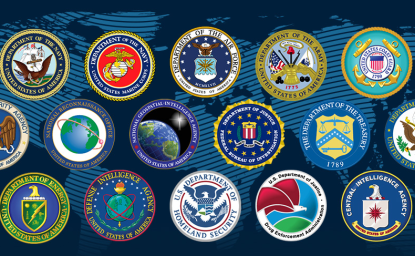
US Intel: ISIS, al Qaeda, Hamas, & Hezbollah

